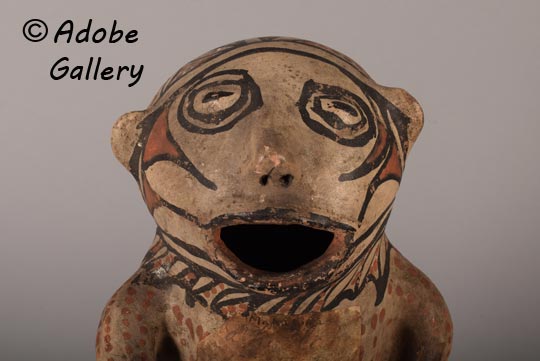Rare Cochiti Pueblo Magnificent Historic Mono Figurine, circa 1890s
+ Add to my watchlist Forward to Friend
Forward to Friend
- Category: Figurines
- Origin: Cochiti Pueblo, KO-TYIT
- Medium: clay, pigment
- Size:
16-¾” height x 6” width x 5-½” depth
Includes Professional Stand - Item # C4882A
- Price: $9850
This historic and exceptional 19th-century Mono pottery figurine from Cochiti Pueblo, stands at an impressive 16-¾ inches tall. It is a very rare and monumental example of its kind. It is likely representing an event that occurred in 1898-1899 — an epidemic of smallpox — that devastated New Mexico Pueblo Indians. The red dots on the body and arms of the figurine most likely represent the outbreak of smallpox. This figure was crafted with an overall cream slip covering the body and intricate designs rendered in black and red pigments.
The details of this figure are captivating: his slightly bulging eyes are encircled by black, and red polka dots decorate both arms and the left side of his torso. The right side of his torso features black-outlined leaf designs, while his legs are adorned with elaborate red stripes bordered in black. He wears black moccasins, and similar patterns to those on his trousers also embellish his neck and cheeks. The back of the figurine is equally impressive, covered with intricate designs that speak to the potter's artistic skill.
The history of Mono figurines is closely tied to the opening of the Santa Fe Trail in 1821, which brought an influx of travelers to Santa Fe and its surrounding areas. By the late 19th century, as Eastern museums sought to collect ethnographic and ceremonial items from the pueblos, Santa Fe merchants began commissioning local potters to produce pottery that catered to this growing demand. Jake Gold, a prominent Santa Fe merchant, was among the first to commission potters from Cochiti and Tesuque, resulting in unique creations like Tesuque Pueblo Rain God figurines and Cochiti Pueblo Mono figures.
The inspiration for Mono figurines arose from the pueblo potters' exposure to the diverse newcomers traveling through Santa Fe — Hispanic settlers, merchants, opera singers, monks, and padres. These human forms, often created to mock the unfamiliar and amusing traits of these outsiders, brought laughter and artistic expression to the pueblo communities. Mono figurines, like this one, were produced between the 1880s and early 1900s, serving as both cultural commentary and items of trade.
The figure's legs were broken, but they were ingeniously repaired with handmade wire staples, a method so effective that the repairs have been preserved in their original state. To ensure a secure display, a custom metal stand has been crafted for this remarkable piece.
This Mono figurine is not just a striking example of Cochiti pottery but a profound reflection of cultural exchange, artistic adaptation, and historical narrative. It represents the creativity and humor of Cochiti potters during a transformative period in the American Southwest.
Condition: remarkable condition for a piece of its age. Historic repairs have been left visible.
Provenance: this Rare Cochiti Pueblo Magnificent Historic Mono Figurine, circa 1890s is from the collection of a private collector in Pennsylvania.
Recommended Reading: CLAY PEOPLE Pueblo Indian Figurative Traditions. Compiled and edited by Jonathan Batkin, Wheelwright Museum of the American Indian. 1999
TAGS: Southwest Indian Pottery, Cochiti Pueblo, Ko-Tyit, Pottery Fgurines

- Category: Figurines
- Origin: Cochiti Pueblo, KO-TYIT
- Medium: clay, pigment
- Size:
16-¾” height x 6” width x 5-½” depth
Includes Professional Stand - Item # C4882A
- Price: $9850
Adobe Gallery Recommended Reading
Adobe Gallery Recommended Items
If you are interested in this item, we would also like to recommend these other related items:



